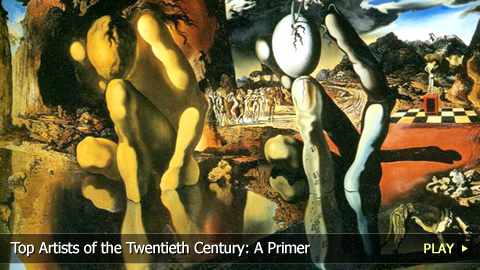Top Artists of the Twentieth Century: A Primer

PABLO PICASSO (1881-1973) – Abstract Art/Cubism
Pablo Picasso is considered by many to be the greatest artist of the twentieth century, and – in fact – one of the greatest of all time. The Spanish artist is world-famous for helping found the cubist art movement. This style was able to inject various different perspectives into one, two-dimensional painting. Picasso seriously questioned realism in art, and pushed the boundaries past it. His work can be separated into several notable periods, including the Blue and Rose periods. In these cases, his art from these timeframes are monochromatic pieces. Les Demoiselles d’Avignon and Guernica are two of his most famous paintings, and they demonstrate the breadth and scope of his influence on modern art.
SALVADOR DALI (1904-1989) – Surrealism
A versatile artist, Dali worked with a variety of media in his career, including photography, filmmaking and sculpture on top of his paintings. He was influenced from a number of artistic movements that came before him, including Cubism and even the Italian Renaissance. His work is easily described as bizarre and absurd, though its creativity is unparalleled. The Spanish artist used Freudian dream imagery in his work, and described his work as hand-painted dream photographs. His best-known work is The Persistence of Memory, and this painting is often referenced in pop culture. Dali also collaborated with Walt Disney during his career. The resulting animated short took over half a century to be completed, and it was called Destino. Combining Dali’s surreal artwork with Disney’s characters, the film was nominated for the 2003 Academy Award for Best Animated Short.
JACKSON POLLOCK (1912-1956) – Abstract Expressionism
Jackson Pollock is considered one of America’s most important twentieth century artists. A leader in the abstract expressionist movement, his paintings are huge in scale and instantly recognizable. Pollock did not only use paint brushes to create his art, but also more unusual tools like trowels and knives. The drip technique that he developed evolved into what is now called “action painting.” This method is more spontaneous than traditional painting with a brush on canvas, and is the epitome of abstract art. He helped cultivate the idea of the painting as an object in itself, as opposed to the notion of a painting needing to represent another object. While he is famous more for his style than any one particular painting, his oeuvre called No. 5, 1948 fetched $140 million when it was sold in 2006.
ANDY WARHOL (1928-1987) – Pop Art
Andy Warhol is as famous for his persona as he is for his art. Starting out as a commercial artist, Warhol used the techniques he learned there to perfect his pop art. Manipulating iconic American symbols became a signature. His Campbell’s Soup Cans, Coca-Cola bottles, as well as representations of celebrities like Marilyn Monroe and Elvis are noteworthy. He often used a silk-screening technique to create his fine arts in his New York workshop called The Factory. Because of his chosen system, he was easily able to delegate his work to other people, which he often did. This destroyed the importance of the artist, and placed the artwork firmly in the spotlight. Though he was commended by many, Warhol was also heavily criticized in his time for overly-accepting consumerism. His works were bold, colorful and prompted the question: what is art?
